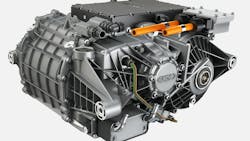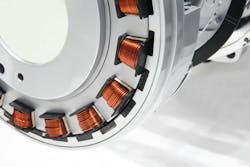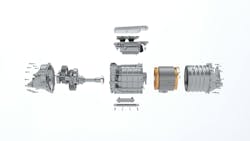Maximizing Efficiency: The Next Frontier in Electric Motor Technology
In the early stages of the electric transition, priorities have largely centered around improving the range and performance of electric vehicles (EVs). The expectation for these vehicles to deliver range that is comparable to their internal combustion engine (ICE) counterparts has been a key factor driving innovations to make them more attractive to the consumer and enable their mass adoption.
The question of efficiency is central to improvements here, with developments in performance and range ultimately determined by how efficiently the energy in the battery can be converted into miles traveled.
As the transition continues, though, the initial focus on range and performance is evolving to include questions around cost and resource efficiency, demanding new solutions for future technologies. Recent developments in electric motor technology are set to play a key role in accelerating the shift to sustainable transportation.
Advancements in Efficient Torque Generation for Electric Motors
One of the key focus areas as far as improving efficiency is concerned is on the efficient generation of torque — this involves the transformation of electrical energy in the battery into mechanical energy in the driveline system to produce torque which is then transferred to the wheels. Within the torque generation system, the advancement of electric motors plays a pivotal role in extending range and enhancing performance.
In recent years, we’ve seen considerable progress made in EV motor design and technology, covering everything from efficiency to power density. Already, today’s motors are operating at up to 25,000 rpm when, 10 years ago, 15,000rpm was quite common.
Motor designs such as permanent magnet synchronous motors have dominated, with the design improved and adapted over time to improve efficiency and increase output.
Using high-strength magnets contributes to higher magnetic flux and torque output. While optimised winding configurations enhance magnetic coupling and thermal management, it also reduces resistance losses and torque ripple.
Together, these factors enable the production of high-torque, efficiency- and NVH (noise, vibration and harshness)-optimized permanent magnet motors.
READ MORE: How Graphene Could Improve the Efficiency of Electric Motors
Motor Efficiency Benefits from Thermal Management Improvements
While electric drivetrains have fewer mechanical elements than traditional combustion engine architectures — producing less heat and offering durability benefits for other systems — EV motors still generate a considerable amount of heat during operation which, in turn, leads to energy losses.
These losses are primarily caused by resistance encountered by the flow of electric current through various components in the motor, leading to the generation and dissipation of energy in the form of heat. Iron losses due to magnetization hysteresis and eddy currents as well as mechanical losses are additional loss types inherent to electrical motors and contributing to further heat generation.
Although today’s motors are 90% efficient in more than 90% of the operating points, the question of reducing these losses remains high on the agenda. This can be achieved via advanced thermal management technologies, to improve the efficiency, longevity and performance of EV motors.
For the various components within an EV motor to operate at their optimal temperatures, and to avoid altering the motor’s thermal conductivity, causing demagnetization or material degradation, the motor should be kept at less than 180 C (356 F).
Currently, most motors are cooled via indirect methods, using an external water jacket. While this approach enables an increase in the continuous torque supply, it doesn’t alter the fact that the heat is being produced within the active parts of the motor.
As such, we’re seeing a greater focus on the development of direct cooling methods, particularly for high-performance drivetrains, using oil to dissipate heat from the windings, stator and rotors. These methods include:
- manifold dripping cooling – cooling fluid is precisely directed onto the motor winding heads
- shaft centrifugal cooling – the rotor’s central shaft is used to spray oil to the head windings
- shaft splashing cooling – the shaft’s rotation force is used to distribute oil along the winding heads.
Internally-cooled electric motors, though still undergoing further optimization, are starting in large EVs before eventually being democratized through all EVs.
In addition to minimizing heat losses, utilizing direct cooling methods such as these also enables the removal of the external water jacket seen in indirect motor cooling solutions, delivering a smaller, lighter and more affordable package, without compromising the power output.
Resource- and Cost-Efficiency Focus Brings Potential for New Electric Motor Designs
It is this notion of downsizing that OEMs across the globe are pursuing, with a goal to simultaneously improve cost-effectiveness and efficiency, whilst targeting more sustainable, resource-efficient solutions.
Driven by international environmental initiatives, such as the Science-Based Targets initiative, and the increasing emphasis placed on total life cycle impact, this, in turn, requires new solutions, influencing the direction of future technologies.
To take an example, for the production of permanent magnet motors, neodymium magnets (a strongly magnetic rare earth material commonly used in electric motors) have historically been used. In order to extract the neodymium, however, the rare-earth magnet materials have to be broken down which causes significant environmental pollution, with the mining and purification process accounting for the vast majority of the carbon footprint during production.
To reduce dependence on rare-earth materials which are not widely available in regions such as Europe manufacturers are starting to introduce localization strategies that eradicate the use of critical materials which are not locally available. This works not only to discourage their widespread use, but also to ensure stable supply chains and improve sustainability by avoiding transporting these materials across the world.
In the case of the permanent magnet machines (i.e. motors) which are dominant today, this could create a market for alternative motor designs which are less reliant on these critical materials.
With alternative designs, such as electrically excited motors, the magnets can either be dispensed with altogether, or the motor can be designed in such a way that it is subjected to a lower thermal load.
We are already seeing trends towards using asynchronous machines, with ferrite or recycled magnets, while switched reluctance machines could also have a place in the longer term.
Other factors that must be considered include a reduction in the amount of copper used in the motors, the origins and chemistry of the steels being used, and the lubrication oils and their source.
READ MORE: Revenue Potential Increasing for Electric Truck Powertrain Components
AI and Digitalization Can Aid Efficient Motor Development
As artificial intelligence (AI) becomes ever more intelligent, we are already seeing the benefits of using algorithms to further improve efficiencies in testing and development.
We are using AI system simulations to specify and choose the right components in the powertrain for the required customer specifications. This allows for the selection of the most efficient eDrive system, made up of the motor, inverter and software, transmissions and actuators, all of which are tailored to meet the customers’ preferred vehicle requirements.
The tools range from AI algorithms to choose the defining customer parameters, to modeling using Finite Element Method (FEM) – examples of which include structural or fluid behavior, thermal transport and wave propagation. This focuses on the optimization of subsystems like the eMotor by, for example, looking at predicted wave propagation for NVH.
By finding efficiencies throughout the vehicle and component development process, we can:
- accelerate the development timeline,
- improve cost efficiency through increased feature robustness upfront, and
- reduce resource consumption during testing.
Importantly, it allows us to provide the best, most efficient solution for our customers.
Our position as a development partner to most global OEMs means that it is our ambition to drive forward these developments in electric motor technology.
By adopting a system-based approach, and offering modular eDrive units with the motor, inverter, software and controls built in, we are able to deliver systems which require less space, less material to manufacture and are lighter than before.
As the industry edges closer towards the mass adoption of electric vehicles, innovative solutions to these questions around size, weight and resource efficiency will go a long way to help reach price parity with ICE vehicles and accelerate the shift to sustainable transportation.
This article was written and contributed by Andreas Mair, Director of Mechanical Engineering at GKN Automotive.
About the Author

Andreas Mair
Director of Mechanical Engineering
As Director of Mechanical Engineering within GKN Automotive's ePowertrain division, Andreas Mair is responsible for product developments in the electrification and hybridization of drivetrains, including electric motor developments. With 27 years' experience in the automotive sector, Andreas has overseen and supported the transformation from combustion engine drivetrains for 2WD and AWD vehicles, to complete powertrains for hybrid and electric vehicles.

Leaders relevant to this article:



